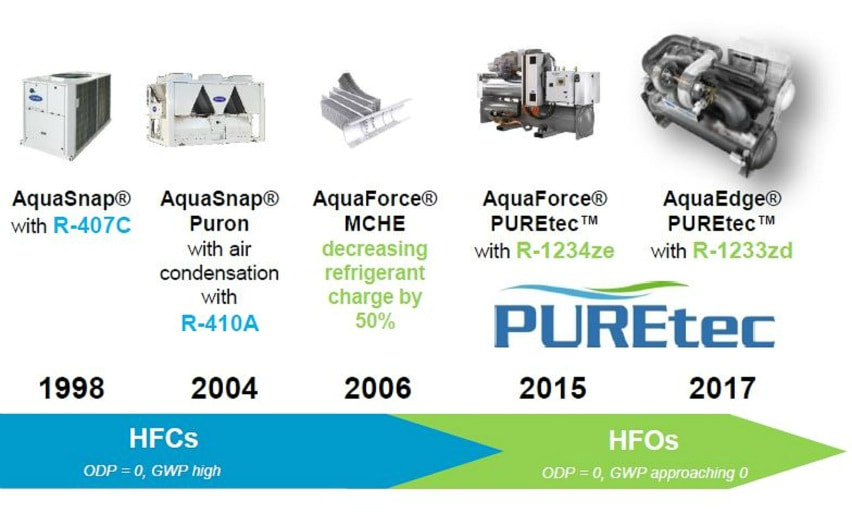05 June 2019
|
| Carrier has confirmed that it will choose low GWP HFO refrigerants for most of its commercial heating, ventilating and air conditioning products in Europe. The manufacturer says it is committed to delivering solutions that preserve the environment and comply with the European Union’s F-Gas Regulations. It adds that in Europe it has achieved a reduction of the refrigerant charge in its products of up to 50% over the last five years. |
Carrier has been working to select the best candidate to replace the R134a in screw and centrifugal chillers and R410A in scroll chillers, heat pumps and rooftop units.
For screw chillers and heat pumps, Carrier selected R1234ze to replace R134a. With a GWP less than 1, R1234ze(E) is not impacted by restrictions from the EU F-gas regulation or the Kigali Amendment of the Montreal Protocol on fluorinated greenhouse gases. It is part of the Carrier PUREtec family of long-term refrigerant solutions. Carrier was the first to launch the newest generation of its AquaForce chillers with PUREtec refrigerant three years ago and says more than 300 units have now been installed in Europe, Middle East and Africa, with more than 2 million cumulated hours and proven reliability . Products in this range are improving product efficiency by an average of 10%, already exceed Eco-design 2021 requirements and meet today the Kigali Amendment requirements for 2036.
Carrier chose R1233zd(E) as the preferred long-term refrigerant for centrifugal chillers. With a GWP of 1, again it is also not impacted by F-Gas regulations.
For scroll commercial chillers and heat pump ranges, Carrier adds that currently available compressor technology is not compatible with low GWP HFO refrigerants. Some solutions operate with mid-GWP HFC refrigerants and Carrier is developing a full range of cooling and heating products that will comply with and exceed Eco-design 2021 efficiency requirements and operate with mid-GWP HFC refrigerants. These ranges are expected to very soon and are optimised for energy efficiency while offering the same operating temperature flexibility as current units operating with R410A.
For screw chillers and heat pumps, Carrier selected R1234ze to replace R134a. With a GWP less than 1, R1234ze(E) is not impacted by restrictions from the EU F-gas regulation or the Kigali Amendment of the Montreal Protocol on fluorinated greenhouse gases. It is part of the Carrier PUREtec family of long-term refrigerant solutions. Carrier was the first to launch the newest generation of its AquaForce chillers with PUREtec refrigerant three years ago and says more than 300 units have now been installed in Europe, Middle East and Africa, with more than 2 million cumulated hours and proven reliability . Products in this range are improving product efficiency by an average of 10%, already exceed Eco-design 2021 requirements and meet today the Kigali Amendment requirements for 2036.
Carrier chose R1233zd(E) as the preferred long-term refrigerant for centrifugal chillers. With a GWP of 1, again it is also not impacted by F-Gas regulations.
For scroll commercial chillers and heat pump ranges, Carrier adds that currently available compressor technology is not compatible with low GWP HFO refrigerants. Some solutions operate with mid-GWP HFC refrigerants and Carrier is developing a full range of cooling and heating products that will comply with and exceed Eco-design 2021 efficiency requirements and operate with mid-GWP HFC refrigerants. These ranges are expected to very soon and are optimised for energy efficiency while offering the same operating temperature flexibility as current units operating with R410A.
Content continues after advertisements








